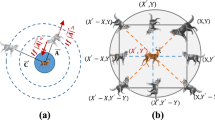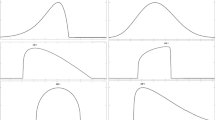Abstract
A new evolutionary optimization scheme for designing a Takagi-Sugeno fuzzy model is proposed in this paper. To achieve better modeling performance, asymmetric RBF membership functions are used. Penalty function is proposed and used in the fitness function to prevent overlapping membership functions in the resulting fuzzy model. The simplified fitness sharing scheme is used to enhance the searching capability of the proposed evolutionary optimization algorithm. Some simulations are performed to show the effectiveness of the proposed algorithm.
This work is partially supported by KOSEF under the Korea-Japan basic scientific promotion program and by HWRS-ERC
Access this chapter
Tax calculation will be finalised at checkout
Purchases are for personal use only
Preview
Unable to display preview. Download preview PDF.
Similar content being viewed by others
References
Y. Shi, R. Eberhart and Y. Chen, Implementation of Evolutionary Fuzzy Systems, IEEE Trans. on Fuzzy Syst., vol. 7, No. 2, (1999) 109–119
Marco Russo, Genetic Fuzzy Learning, IEEE Trans. on Evolutionary Computation., vol.4, No. 3, (2000) 259–273
S. J. Kang, H. S. Hwang and K. N. Woo, Evolutionary design of fuzzy rule base for nonlinear system modeling and control, IEEE Trans. Fuzzy Syst., vol. 8, (2000) 37–45
T. Takagi and M. Sugeno, Fuzzy identification of systems and its applications to modeling and control, IEEE Trans. Syst., Man, Cybern., vol. 15, (1985) 116–132
Min-Soeng Kim, Sun-Gi Hong, and Ju-Jang Lee, Evolutionary design of a fuzzy system for various problems including vision based mobile robot control, Proc. 2002 IEEE/RSJ Intl. Conf. Intelligent Robots and Systems, EPFL, Lausanne, Switzerland, (2002) 1056–1061
M. Setnes and H. Roubos, GA-fuzzy modeling and classification: complexity and performance, IEEE Trans. Fuzzy Syst., vol. 8, (2000) 509–522
Min-Soeng Kim and Ju-Jang Lee, Evolutionary design of Takagi-Sugeno type fuzzy model for nonlinear system identification and time series prediction, Proc. the Int’l Conf. on Control, Automation and Systems, Oct. Cheju Univ. Korea, (2001) 667–670
B. Sareni and L. Krähenbühl, Fitness sharing and niching methods revisited, IEEE Trans. on EC, vol. 2, no. 3, (1998) 97–106
Michalewicz, Z.: Genetic Algorithms + Data Structures = Evolution Programs. 3rd edn. Springer-Verlag, Berlin Heidelberg New York (1996)
M. Gen and R. Cheng, Genetic algorithms & enginerring optimization, John Wiley & Sons, Inc., (2000)
J. Yen and L. Wang, Simplifying fuzzy rule-based models using orthogonal transformation methods, IEEE Trans. Syst., Man, Cybern., pt, B, vol. 29, (1999) 13–24
Author information
Authors and Affiliations
Editor information
Editors and Affiliations
Rights and permissions
Copyright information
© 2003 Springer-Verlag Berlin Heidelberg
About this paper
Cite this paper
Kim, MS., Kim, CH., Lee, JJ. (2003). Evolutionary Optimization of Fuzzy Models with Asymmetric RBF Membership Functions Using Simplified Fitness Sharing. In: Bilgiç, T., De Baets, B., Kaynak, O. (eds) Fuzzy Sets and Systems — IFSA 2003. IFSA 2003. Lecture Notes in Computer Science, vol 2715. Springer, Berlin, Heidelberg. https://doi.org/10.1007/3-540-44967-1_75
Download citation
DOI: https://doi.org/10.1007/3-540-44967-1_75
Published:
Publisher Name: Springer, Berlin, Heidelberg
Print ISBN: 978-3-540-40383-8
Online ISBN: 978-3-540-44967-6
eBook Packages: Springer Book Archive





